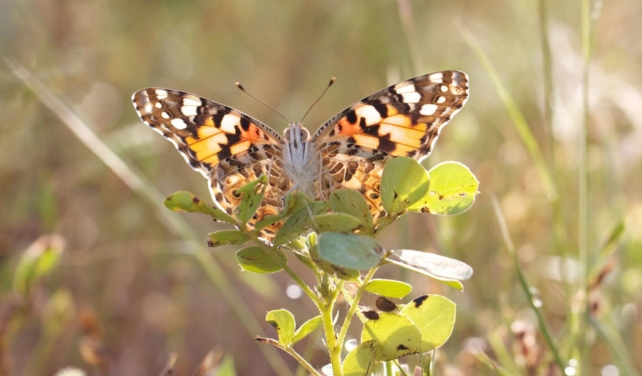Some butterflies may be able to journey across entire oceans with the help of the wind.
A world-first study has now shown that the painted lady butterfly (Vanessa cardui) can cross the world’s second-largest ocean, the Atlantic, covering 4,200 kilometers (2,610 miles) in as few as five to eight days.
The trip, researchers claim, “is among the longest documented for individual insects, and potentially the first verified transatlantic crossing.”
The incredible discovery was made after more than a decade of mystery.
It all started in 2013, when a flock of fatigued butterflies landed on the beaches of French Guiana with torn and tattered wings. The entomologist, Gerard Talavera, who found the insects resting on the sand early one October morning, was shocked.
These were painted lady butterflies – a common species with stable populations found on every continent except Antarctica and South America.
For years Talavera was left wondering: how did the insects get to South America, and where did they come from? At last he has an answer.
Analyzing the DNA of pollen left on the butterflies, Talavera and his colleagues at the Botanical Institute of Barcelona have shown that this lost flock probably flew in from sub-Saharan Africa, after undertaking an accidental transatlantic trip.
It seems the adult insects were caught up in a strong trade wind in 2013 and blown 4,200 kilometers off course.
Judging by trade winds that year, the trip would have taken the butterflies about five to eight days. With nowhere to land, the insects would have had to use their wings sparingly.
Without the help of powerful winds, the researchers theorize the flock would have only gotten about 780 kilometers before eating through all their energy and perishing.
“Our findings suggest that we may be underestimating transoceanic dispersal in insects and highlight the importance of aerial highways connecting continents by trade winds,” write Talavera and his colleagues.
The Monarch butterfly (Danaus plexippus) is world famous for its nearly 5,000-kilometer-long migration, which it makes each year from North America to Mexico, but painted lady butterflies also undertake long-distance trips between Europe and Africa each year. Some studies suggest a single generation can migrate more than 4,000 kilometers.
That would make it the butterfly with the longest lifetime migration, but unlike other animals that travel through the air, like birds, it’s a lot harder to track the global movements of little creatures like insects.
The wings of the painted lady butterflies in French Guiana were found to contain isotopes that suggest they were born in Western Europe. This means the flock may have traveled more than 7,000 kilometers in one lifetime, visiting no less than three continents.
“It is the first time that this combination of molecular techniques including isotope geolocation and pollen metabarcoding is tested on migratory insects,” says geochemist Clément Bataille from the University of Ottawa in Canada.
“The results are very promising and transferable to many other migratory insect species. The technique should fundamentally transform our understanding of insect migration”.
While long-distance migration from Europe to Africa or North America to Central America is undoubtedly impressive, there are also plenty of places for butterflies to stop in between and refuel. An ocean crossing is a whole other challenge.

Painted ladies may only have wings the size of a pinky finger and a brain the size of a pinhead, but they are incredible fliers.
In fact, their tiny size gives them an advantage. It allows the species to glide on the winds, sometimes going as fast as 48 kilometers (30 miles) an hour.
It’s not just these lowly insects that scientists are underestimating, either.
The winds that blow across the Atlantic from the Sahara to the tropical Caribbean are also stronger than experts once thought, capable of carrying large particles of dust as far as 3,500 kilometers.
It makes sense that a small winged creature could make it pretty far gliding on these winds with minimal flapping effort.
“We usually see butterflies as symbols of the fragility of beauty, but science shows us that they can perform incredible feats,” says entomologist Roger Vila from CSIC-Pompeu Fabra University in Spain.
“There is still much to discover about their capabilities.”
The study was published in Nature Communications.

Dr. Thomas Hughes is a UK-based scientist and science communicator who makes complex topics accessible to readers. His articles explore breakthroughs in various scientific disciplines, from space exploration to cutting-edge research.








